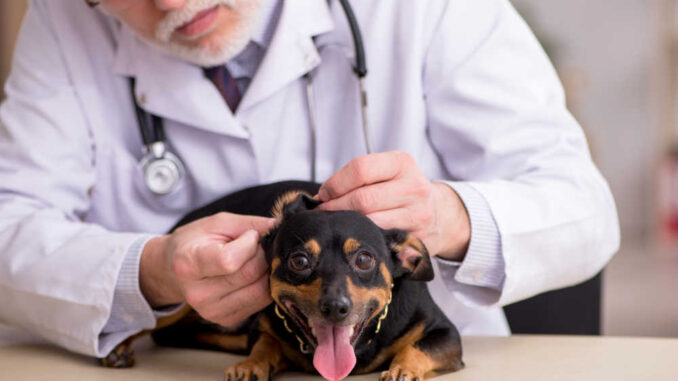
This article was updated on March 12th, 2024

White lumps and bumps might seem unusual. However, as a veterinarian, I have seen them more often than you might think. In this article, I will explain the most common causes, with pictures to help you understand what might be going on with your dog.
Top causes of white bumps
1. Skin infections
Bacterial skin infections (pyoderma) are a common cause of little white bumps (pustules). They can occur anywhere, either in a focal area or diffusely.
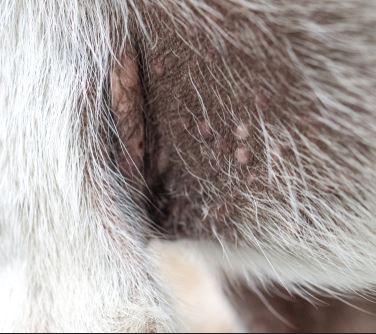
With skin infections, dogs will usually be itchy or sore and you’ll likely notice some redness of the skin. Infections can occur in skin folds or as a result of scrapes, grazes, or conditions like allergies.
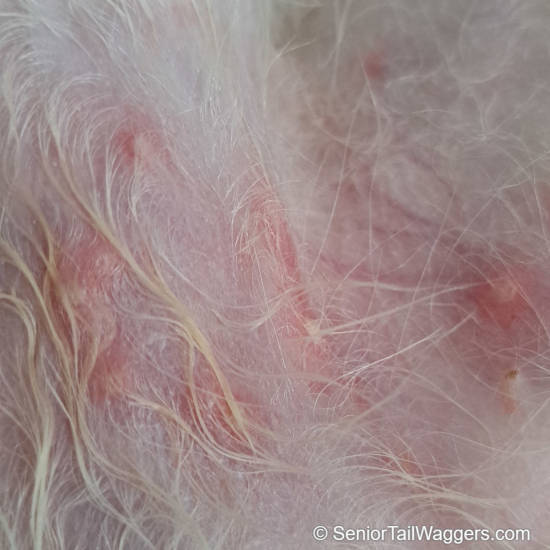
Infections may also result in an abscess, especially if a foreign body, like a grass seed, is present. These appear as large white or reddened, inflamed lumps, usually developing over a few days. They’re usually painful when touched and may ooze pus. Abscesses often require drainage and your dog may need to be sedated for the area to be flushed out.
Skin infections need veterinary attention and may be treated by topical products or antibiotics.
Learn more about Skin Infections: Pictures, Symptoms, Treatments.
2. Cysts filled with white material
Cysts are benign lumps that develop within the skin, often growing slowly larger over time and appearing as a visible bump on the surface of the skin. They’re filled with thick white, yellow, brown, or grey material, which may be seen oozing out if they rupture.
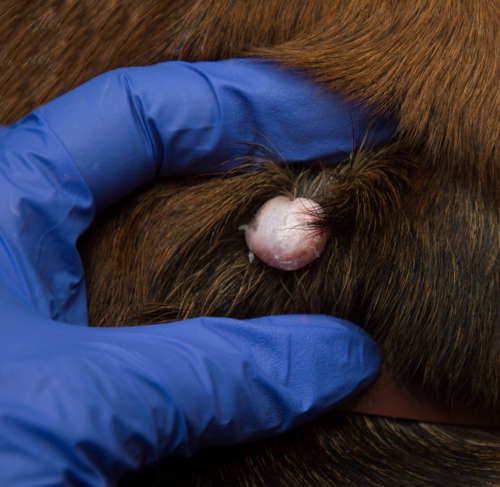
Several types of cysts exist, including follicular and sebaceous cysts, and the exact appearance can vary, but they’re usually non-painful, relatively firm, and range from blueish-white to pink in color. These lumps are very common, especially in our older patients.
In the picture below, a cyst looks like a round and elevated pale white bump that is smooth and has a small area of black pigment (this could also be a blocked hair follicle):
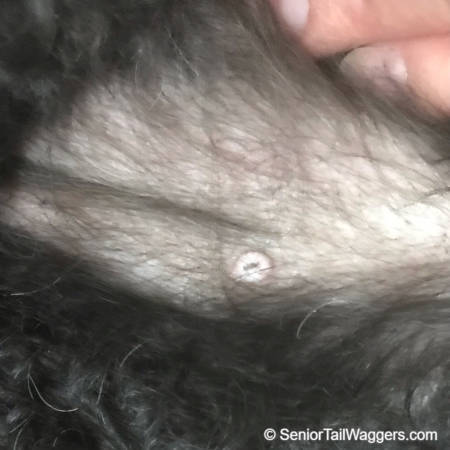
It’s best to get your vet to check any lump you suspect of being a cyst – they can take a small sample to confirm it contains material consistent with a cyst. Usually, cysts don’t require any treatment, but surgery is usually curative if they’re causing irritation.
Learn more about the different types of cysts in dogs (with pictures).
3. White warts, skin tags, and other benign lumps
Various small benign growths can develop on dogs’ skin, including warts (primarily in young dogs on the feet and muzzle) and skin tags. Warts, caused by papillomaviruses, are usually ‘cauliflower like’ and can be white, whiteish, pink, tan or more pigmented in color. They usually resolve on their own over several weeks to months.
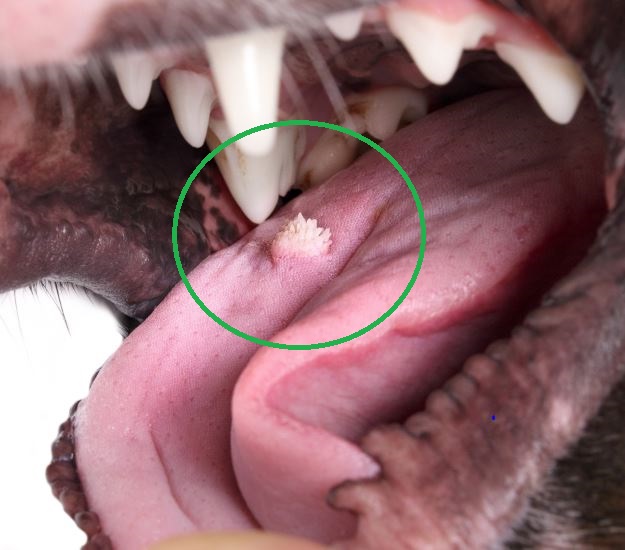
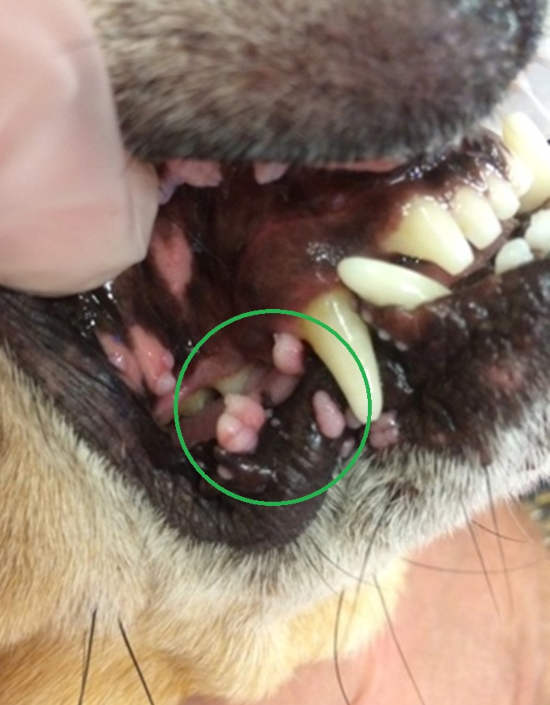
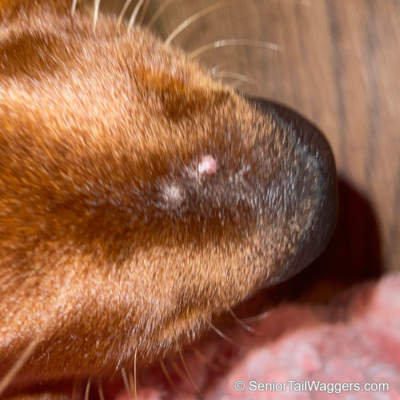
Skin tags can be seen on any dog and are often common in older patients – they’re usually soft, fleshy, and relatively small and can be a white or pink color, as shown in the picture below:
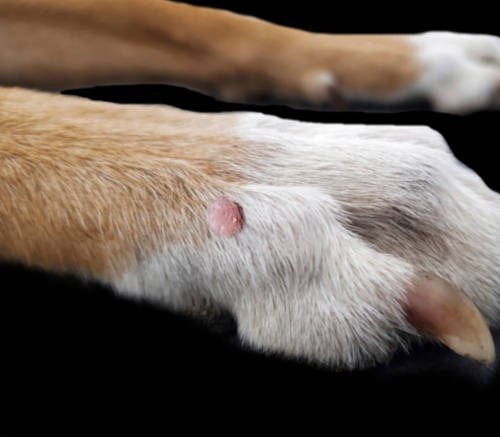
Warts are typically found in young dogs and the ‘warts’ often seen in older dogs are usually a different type of benign lump like a sebaceous adenoma – these are benign and don’t usually cause a problem but will persist, unlike true warts.
You shouldn’t attempt to remove these kinds of lumps at home, and they usually don’t need any treatment at all – if your dog has any kind of persistent new lump, however, it’s worth getting a vet to rule out any more unpleasant causes. Learn more about skin tags & warts or “It is a wart or a skin tag?“.
4. Tumors
We do, unfortunately, see a range of malignant tumors that can have very variable appearances, including sometimes appearing as white bumps – especially early on. These include soft tissue sarcomas and mast cell tumors.
Malignant lumps more commonly appear as rapidly growing, often inflamed lumps – especially in the case of mast cell tumors – but any new lump should be checked to rule out a malignant tumor, especially if it’s growing rapidly. Learn more about Tumors in Dogs.
5. Corns on paws (keratomas)
These proliferations of keratin-producing cells on the pads usually appear as firm, raised white bumps on the bottom of the pads. They typically occur in sighthounds like Greyhounds and are usually painful if pressed, causing lameness. They’re benign but typically progress to cause further pain, so treatment is recommended.
6. Ticks
Ticks are common parasites that can appear as white bumps on the skin similar to a skin tag. You should check your dog after walks, and if you suspect a tick, look for small black legs near the surface of the skin. Ticks should be removed as soon as you spot them.
Learn more about ticks and how to remove them.
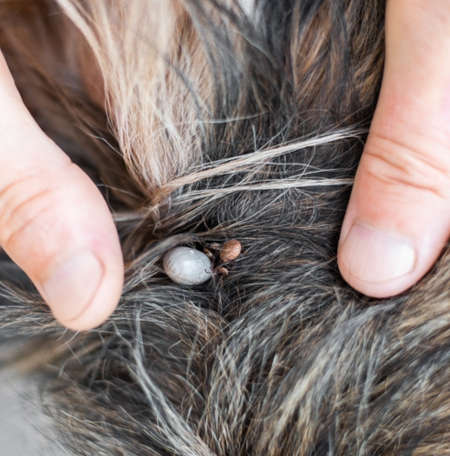
7. Lipomas
Lipomas are incredibly common benign fatty lumps that develop under the skin. They’re usually soft, moveable, non-painful, slow growing and well-demarcated. They don’t affect the overlying skin but you may notice a bulge associated with one growing beneath the skin. Surgical removal is curative but often isn’t required.
View more pictures of lipomas.
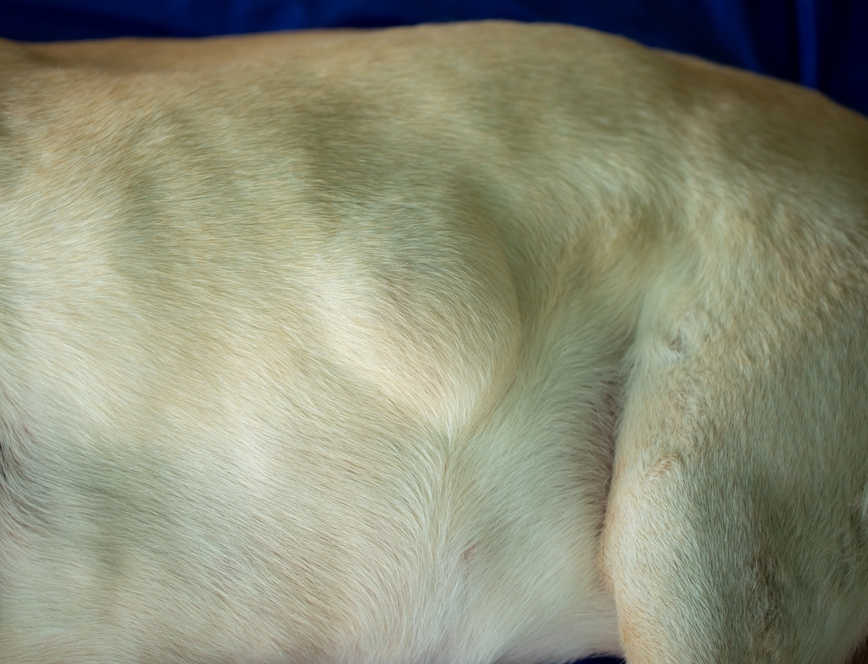
White bumps: what does the color “white” mean?
A white bump on a dog could indicate various conditions, including a skin infection, a cyst, pimple, or pustule, and should be examined by a veterinarian for proper diagnosis and treatment.
You should consult your vet if you notice a new lump that persists or grows rapidly, or if a lump causes irritation or pain. These signs indicate that a white lump could be more concerning.
Signs that you need to see your veterinarian
A veterinarian should check out any new lump on your dog to make sure it’s not malignant, but the following lumps are particularly concerning:
- Persistent new lump
- Lumps that grow rapidly
- Lumps that cause irritation or pain
Learn more:
Common Lumps and Bumps & What to Do
How Do You Know if a Lump is Cancerous?
What will happen at the vet
Your vet will often be able to advise you of the likely cause based on their clinical examination, especially if something like an infection is responsible. If there’s a growth present, they may recommend a fine needle aspirate to take a small sample to be assessed under microscopy for a more definitive diagnosis. This usually costs $150-$250. Learn more: diagnosing lumps in dogs with FNAs and biopsies.
Disclaimer: This website's content is not a substitute for veterinary care. Always consult with your veterinarian for healthcare decisions. Read More.


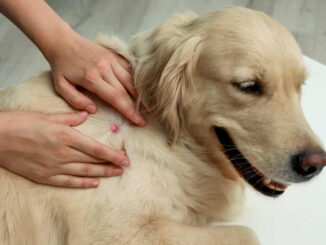
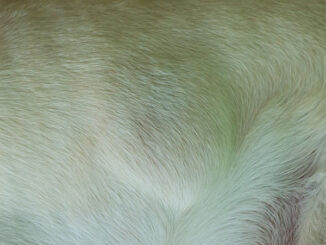

How much is the price to drain a cysts?
Hi Denise, this is Dr Linda, a vet with 10 years of clinical experience.
The cost of draining a cyst will be very variable. It depends on a range of factors including: The size of the cyst, if the pet needs sedation, the general prices in the clinic you go to etc.
Draining a cyst provides temporary relief as they generally re-fill quite quickly.
Removing a cyst (whereby the wall is surgically removed) is oftentimes more appropriate but this involves a surgical procedure under anesthetic so is often several hundred dollars.
“The information on this website is not a substitute for in-person veterinary care. Always seek advice from your veterinarian if you have concerns about your pet’s medical condition.”
My Wheaten Scottie has had white skin bumps on his rear for some time. They aren’t really red but sometimes they scab. If I try to remove them, they bleed. He has had a staff infection on his tail for sometime, too, where there is no hair. At any rate, he is on his second round of Enrofloxacin 204mg flextab, 1/2 once a day. It does seem to make him feel better. He has allergies, but not tested. Gets Cytopoint injection every 2 to 3 months. Is there anything else I can do. I’m thinking about sending some samples to a pathologist. Any help for my 4 year old Scottie would be appreciate. His bumps look like #1 pustule pic you posted. Thanks so much
I’m so sorry to hear about these ongoing skin complaints, I can imagine it is both frustrating and worrying for you.
When lesions are on the rear/rump, we have to wonder about fleas as this would be the classic location for these lesions.
This is especially true if he lives with cats or walks through long grass. I’d firstly eliminate fleas as a possibility by getting all pets up to date with a prescription strength preventative and by deep treating the home.
Another consideration would be the anal glands. When impacted or chronically infected, the dog can gnaw at their rump and cause lesions over their tail. So worth getting them checked and/or emptied by your local vet.
As you say he has allergies, these could absolutely be playing a big role here. The mainstay of ‘treatment’ (there is no cure, we just manage allergies) is to avoid allergen exposure. If unsure what he is allergic to, I’d consider IgE Allergy blood tests with your vet. Confirming what a dog reacts to can help us avoid the trigger, but also means we can pursue immunotherapy if affordable.
You mention Cytopoint every 2-3 months. If it is effective for the first 1-2 months but signs are then re-emerging in the 2-3 months period, you may be leaving too long between injections, allowing the allergy to flare up and infection to flourish. Most of my patients are on 4-6 weekly injections.
If not already done, I’d swab any pustules/ infection, to determine which bacteria is present so we can be happy we are on the right antibiotics.
Other things to consider:
A hydrolysed diet for an 8 week trial, to be fed exclusively
Skin supplements
Regular Hibiscrub bathing of the area
Preventing licking with a buster collar
Referral to a dermatologist for a more refined plan
I hope this helps, and things clear up soon.
“The information on this website is not a substitute for in-person veterinary care. Always seek advice from your veterinarian if you have concerns about your pet’s medical condition.”